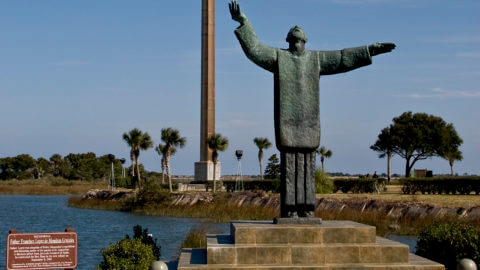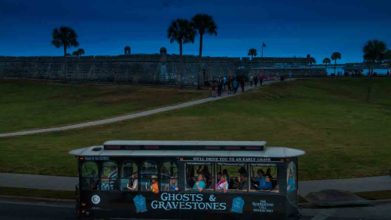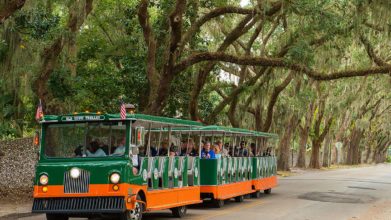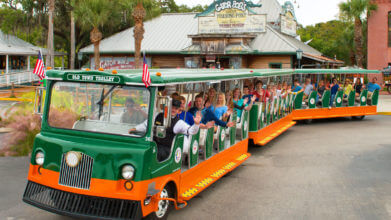On the Grounds: Statue of Father Francisco Lopez de Mendoza Grajales

The 11-foot tall bronze statue which, from certain angles lines up directly in front of The Great Cross, depicts Father Francisco López de Mendoza Grajales, considered to be the first parish priest and the first pastor in the United States. The statue, created by Dr. Ivan Mestrovic, a native of Croatia, portrays Father López in his priestly vestments, preaching the Gospel.
Father
López was the chaplain of the Indies Fleet led by Captain General Don Pedro Menéndez de Aviles, which landed at the village of Seloy on September 8, 1565. Father López’ diary recorded the landing in this way:
“On Saturday the eighth the General landed with many banners spread, to the sounds of trumpets and the salutes of artillery. As I had gone ashore the evening before, I took a cross and went to meet him, singing the hymn “Te Deum Laudamus”. The General, followed by all who accompanied him, marched up to the cross, knelt and kissed it. A large number of Indians watched these proceedings and imitated all that they saw done.”
Following Menéndez’ veneration of the cross, thus proclaiming this land in the name of God (Nombre de Dios), and raising of the King’s flag, thus proclaiming this land also in the name of King Phillip II of Spain, Father López celebrated Mass at a rustic altar made of wood, a depiction of which is found on the Mission grounds. The sky served as the roof for what was the first parish Mass in what is now the United States. The feast for that day was the Nativity or birth of the Blessed Virgin Mary. The Catholic Church continues to mark this feast on September 8 every year.
When the celebration of Mass was completed, Pedro Menéndez hosted a meal of thanksgiving and invited the Native Timucuan people to participate. When noting the significance of the Mass and meal, noted historian Michael Gannon wrote in his book Cross in the Sand: “It was the first community act of religion and thanksgiving in the first permanent (European) settlement in the land.” This thanksgiving meal was celebrated 56 years before the Puritan Pilgrim thanksgiving at Plymouth Plantation in Massachusetts.




